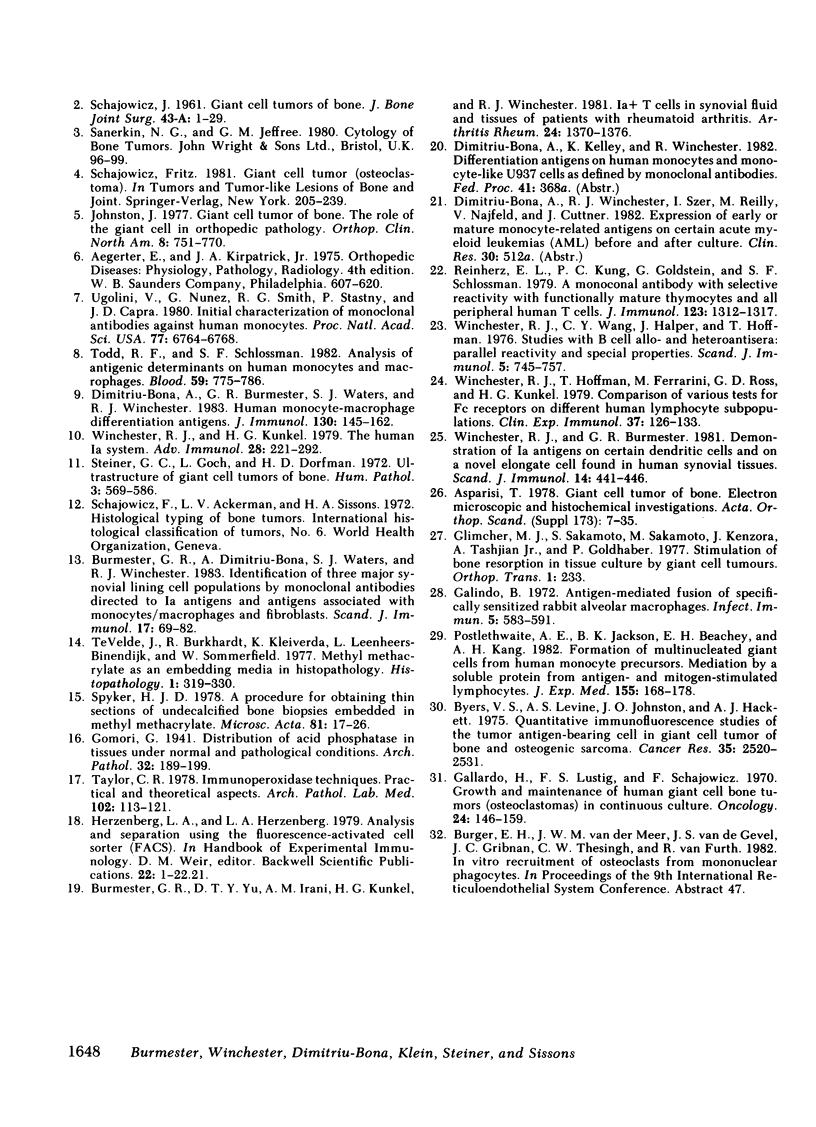Abstract
Giant cell tumors of bone dissociated by collagenase digestion were found to be composed of four different cell types defined by morphology, growth in culture, and pattern of staining with monoclonal antibodies. Giant cells comprised an average of 0.8% of the cells recovered, with the remainder consisting of small stromal cells. Of the giant cells, 20-57% expressed Ia antigens, while all lacked IgG Fc receptors and five differentiation antigens associated with mature members of the monocyte-macrophage lineage (M phi S-1, M phi P-9, M phi P-15, M phi S-39, and 63d3). One antigen, M phi U-50, found on early monocytoid forms was expressed on Ia+ giant cells. 6-36% of the remaining stromal tumor cells formed a second subpopulation that assumed either a rounded or elongated shape in culture. These cells bore Ia antigens, IgG Fc receptors, and five antigens of the monocyte-macrophage lineage usually found on blood monocytes. However, these cells differed from monocytes or macrophages in that the antigen M phi R-17 generally found on tissue macrophages was absent, and the M phi U-50 antigen present on more primitive cells was well expressed. A very limited endocytic capacity was demonstrable. A third population of up to 24% of the tumor cells was defined by the presence of intense staining for Ia antigens but the absence of antigens of mature monocytes. A proportion of these cells expressed M phi U-50 and a minority had IgG Fc receptors. The two Ia(+) populations of stromal cells were not identifiable after 2 wk of culture, nor did tumor cells selected for the presence of Ia antigens proliferate in culture. A fourth population of cells lacked Ia and monocyte lineage antigens, but showed pronounced intracellular staining for acid phosphatase. These cells had a distinctive plump epitheloid to fibroblastoid morphology and were readily established in long-term culture where they gave rise to large multinuclear Ia(-) cells containing acid phosphatase. The possibility is discussed that the cell types of these tumors relate to various stages in the development of osteoclasts from precursors in the mononuclear phagocyte lineage.
Full text
PDF















Images in this article
Selected References
These references are in PubMed. This may not be the complete list of references from this article.
- Burmester G. R., Dimitriu-Bona A., Waters S. J., Winchester R. J. Identification of three major synovial lining cell populations by monoclonal antibodies directed to Ia antigens and antigens associated with monocytes/macrophages and fibroblasts. Scand J Immunol. 1983 Jan;17(1):69–82. doi: 10.1111/j.1365-3083.1983.tb00767.x. [DOI] [PubMed] [Google Scholar]
- Burmester G. R., Yu D. T., Irani A. M., Kunkel H. G., Winchester R. J. Ia+ T cells in synovial fluid and tissues of patients with rheumatoid arthritis. Arthritis Rheum. 1981 Nov;24(11):1370–1376. doi: 10.1002/art.1780241106. [DOI] [PubMed] [Google Scholar]
- Byers V. S., Levin A. S., Johnston J. O., Hackett A. J. Quantitative immunofluorescence studies of the tumor antigen-bearing cell in giant cell tumor of bone and osteogenic sarcoma. Cancer Res. 1975 Sep;35(9):2520–2531. [PubMed] [Google Scholar]
- Dimitriu-Bona A., Burmester G. R., Waters S. J., Winchester R. J. Human mononuclear phagocyte differentiation antigens. I. Patterns of antigenic expression on the surface of human monocytes and macrophages defined by monoclonal antibodies. J Immunol. 1983 Jan;130(1):145–152. [PubMed] [Google Scholar]
- Galindo B. Antigen-mediated fusion of specifically sensitized rabbit alveolar macrophages. Infect Immun. 1972 Apr;5(4):583–594. doi: 10.1128/iai.5.4.583-594.1972. [DOI] [PMC free article] [PubMed] [Google Scholar]
- Gallardo H., De Lustig E. S., Schajowicz F. Growth and maintenance of human giant-cell bone tumors (osteoclastomas) in continuous culture. Oncology. 1970;24(2):146–159. doi: 10.1159/000224514. [DOI] [PubMed] [Google Scholar]
- Johnston J. Giant cell tumor of bone. The role of the giant cell in orthopedic pathology. Orthop Clin North Am. 1977 Oct;8(4):751–770. [PubMed] [Google Scholar]
- Postlethwaite A. E., Jackson B. K., Beachey E. H., Kang A. H. Formation of multinucleated giant cells from human monocyte precursors. Mediation by a soluble protein from antigen-and mitogen-stimulated lymphocytes. J Exp Med. 1982 Jan 1;155(1):168–178. doi: 10.1084/jem.155.1.168. [DOI] [PMC free article] [PubMed] [Google Scholar]
- Reinherz E. L., Kung P. C., Goldstein G., Schlossman S. F. A monoclonal antibody with selective reactivity with functionally mature human thymocytes and all peripheral human T cells. J Immunol. 1979 Sep;123(3):1312–1317. [PubMed] [Google Scholar]
- Spijker H. J. A procedure for obtaining thin sections of undercalcified bone biopsies embedded in methyl methacrylate. Microsc Acta. 1978 Sep;81(1):17–26. [PubMed] [Google Scholar]
- Steiner G. C., Ghosh L., Dorfman H. D. Ultrastructure of giant cell tumors of bone. Hum Pathol. 1972 Dec;3(4):569–586. doi: 10.1016/s0046-8177(72)80007-8. [DOI] [PubMed] [Google Scholar]
- Taylor C. R. Immunoperoxidase techniques: practical and theoretical aspects. Arch Pathol Lab Med. 1978 Mar;102(3):113–121. [PubMed] [Google Scholar]
- Todd R. F., 3rd, Schlossman S. F. Analysis of antigenic determinants on human monocytes and macrophages. Blood. 1982 Apr;59(4):775–786. [PubMed] [Google Scholar]
- Ugolini V., Nunez G., Smith R. G., Stastny P., Capra J. D. Initial characterization of monoclonal antibodies against human monocytes. Proc Natl Acad Sci U S A. 1980 Nov;77(11):6764–6768. doi: 10.1073/pnas.77.11.6764. [DOI] [PMC free article] [PubMed] [Google Scholar]
- Velde J. T., Burkhardt R., Kleiverda K., Leenheers-Binnendijk L., Sommerfeld W. Methyl-methacrylate as an embedding medium in histopathology. Histopathology. 1977 Sep;1(5):319–330. doi: 10.1111/j.1365-2559.1977.tb01671.x. [DOI] [PubMed] [Google Scholar]
- Winchester R. J., Hoffman T., Ferrarini M., Ross G. D., Kunkel H. G. Comparison of various tests for Fc receptors on different human lymphocyte sub populations. Clin Exp Immunol. 1979 Jul;37(1):126–133. [PMC free article] [PubMed] [Google Scholar]
- Winchester R. J., Kunkel H. G. The human Ia system. Adv Immunol. 1979;28:221–292. [PubMed] [Google Scholar]
- Winchester R. J., Wang C. Y., Halper J., Hoffman T. Studies with B-cell allo- and hetero-antisera: parallel reactivity and special properties. Scand J Immunol. 1976;5(6-7):745–757. doi: 10.1111/j.1365-3083.1976.tb03024.x. [DOI] [PubMed] [Google Scholar]









